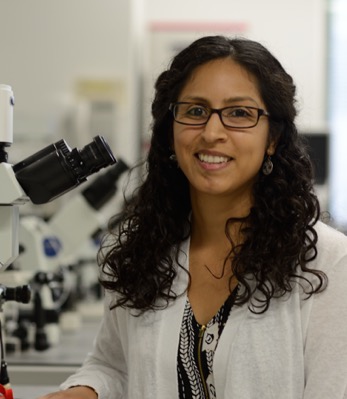CRS Alumni Spotlight on Dr. Diana Monsivais
The community that CRS built was tremendously important for me as a student in the DGP.
Diana Monsivais, PhD
Dr. Diana Monsivais, PhD, is a CRS alumna, class of 2013. Her thesis research, mentored by Dr. Serdar Bulun, focused on the role of estrogen receptors and inflammation on endometriosis using primary-derived endometrial and endometriotic cells as models. She is currently an Assistant Professor in the Department of Pathology and Immunology at Baylor College of Medicine.

Name: Diana Monsivais, PhD
Thesis mentor: Dr. Serdar Bulun
Thesis title: Integration of Nuclear Receptor Actions and Inflammatory Pathways in Endometriosis
What is your connection to the CRS community (mentor and position) and what is your current position?
I was a PhD student in the Driskill Graduate Program at Northwestern University and did my PhD thesis research in the laboratory of Dr. Serdar Bulun in the Center for Reproductive Sciences. My thesis research was focused on the role of estrogen receptors and inflammation on endometriosis using primary-derived endometrial and endometriotic cells as models. I am currently an Assistant Professor in the Department of Pathology and Immunology at Baylor College of Medicine in Houston, TX.
Could you describe your current research/studies?
I started my laboratory at Baylor College of Medicine in July 2020 with the goal of studying the growth factors that control the regenerative potential of the endometrium. In our research we use genetic mouse models and transcriptomics to study infertility, decidualization and placentation processes during pregnancy. We also use primary-derived human and mouse 2D and 3D- endometrial cultures to study the molecular signaling pathways that go awry in women experiencing early pregnancy loss, endometriosis and cancer. We also have collaborative projects with the Center for Drug Discovery at Baylor College of Medicine to use these cellular models for small molecule screening and drug development.
What aspect(s) of CRS did you find most valuable?
I truly enjoyed the opportunity to participate in the social and networking opportunities provided by the CRS, such as the weekly research seminar updates and the annual symposium. They were great opportunities to take a break from the bench and learn about people’s research in reproductive science. I also enjoyed attending the seminars focused on women’s health at the Prentice Women’s Hospital that were organized by Theresa Woodruff. The annual CSR research symposium gave trainees the opportunity to present their research and receive valuable feedback. We also participated in the Illinois Symposium for Reproductive Sciences every year, allowing us to meet other scientists across Illinois that were also studying reproductive science. Overall, the many opportunities for networking were incredibly valuable!
What has been the most valuable aspect to your training as a reproductive scientist in CRS?
The community that CRS built was tremendously important for me as a student in the DGP. Seeing and interacting with scientists at various stages in their career helped me learn about their own experiences and become more aware of different career paths. It also helped shape my own identity as a reproductive scientist and encouraged me to continue training in this important field!
What would you recommend to junior scientists in order for them succeed in their scientific careers?
I strongly recommend that trainees start planning their next career steps early- set up informational interviews with professionals in careers that they find interesting and learn how they obtained their current position. I was interested in teaching when I was a DGP student, so I obtained the Graduate Teaching Certificate Program offered through the Center for Teaching Excellence on the Evanston Campus. This year-long program allowed me to learn about the best teaching strategies for undergraduate student learning and gave me the opportunity to teach as a guest lecturer at Chicago State University. Participating in this program was a key experience helping me obtain an IRACDA Postdoctoral Fellowship at Baylor College of Medicine.
What do you think will be the next big contribution in the reproductive biology field?
The development of organ systems (like Julie Kim’s organ-on-a-chip systems) are very exciting and will be key to dissecting the cross-tissue interactions that are relevant to multifactorial diseases, such as PCOS and endometriosis.
Do you have any notable stories from your time in CRS?
I remember the Holiday parties hosted by Dr. Bulun, the Secret Santa gift exchange game was hilarious, and the Turkish food was delicious!